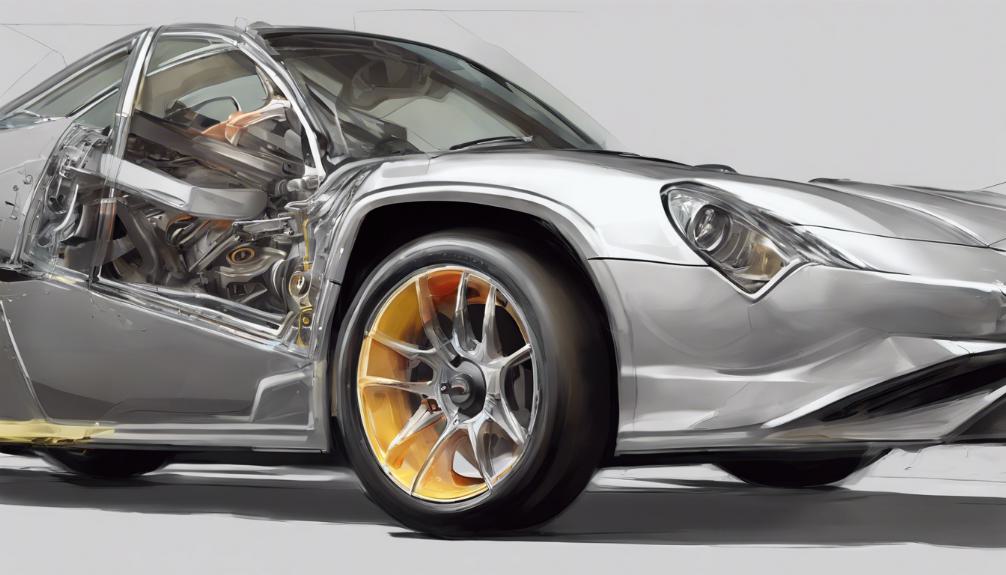Understanding caster angle is essential for steering alignment in your vehicle. Caster angle determines handling characteristics and alignment precision, impacting stability and tire wear.
Aim for a caster angle between 3-5 degrees for best steering response and cornering behavior. Positive caster enhances self-centering steering, but excessive angles can lead to heavier steering effort.
Adjusting caster settings influences driving satisfaction and tire longevity. Proper caster alignment is key for peak performance.
Master the dynamics of steering alignment by grasping the importance of caster angle for enhanced vehicle handling. Discover more insights to perfect your steering system. Dominating the road starts with mastering caster dynamics.
Key Points
- Caster angle affects steering stability and self-centering for improved control.
- Positive caster generates self-aligning torque for better directional control.
- Proper caster alignment optimizes steering response and tire wear.
- Adjusting caster angle impacts steering effort and cornering behavior.
- Caster angle within 3-5 degrees enhances handling characteristics and alignment accuracy.
Importance of Caster Angle

Why is the caster angle essential for steering alignment?
The caster angle plays a vital role in determining the handling characteristics and alignment accuracy of a vehicle.
By setting the caster angle within the typical range of 3 to 5 degrees, you can enhance the self-centering steering effect and improve directional stability.
This means that when you release the steering wheel, the wheels naturally return to the straight-ahead position, making driving more manageable and safer.
Also, the caster angle aligns the steering axis with the road, providing stability to the steering wheels. This alignment not only influences steering precision but also affects cornering and straight-line stability.
By understanding and adjusting the caster angle correctly, you can optimize steering effort, stability, and cornering behavior, ultimately improving tire wear and overall driving experience.
Caster Angle and Vehicle Stability
To enhance your vehicle’s stability and control, understanding the relationship between caster angle and steering dynamics is essential.
The caster angle plays a critical role in determining how your vehicle handles various driving conditions.
A positive caster angle contributes to improved self-centering for the steering wheel, enhancing directional stability and control.
This design causes the steering axis to intersect the road slightly ahead of the tire contact patch center, promoting stability during straight-line driving.
However, excessive positive caster angles can result in heavier steering, while in racing applications, larger angles are utilized to gain camber during cornering maneuvers.
Adjusting the caster angle not only impacts straight-line stability but also influences steering effort, which is crucial for optimal vehicle handling.
By understanding how caster angle affects tire wear, alignment, handling, and cornering, you can make informed decisions to maximize your vehicle’s performance and safety on the road.
Effects on Steering Response

Understanding how caster angle influences steering response is essential for optimizing your vehicle’s handling and control.
The caster angle’s impact on handling is significant, as it plays a critical role in providing self-centering torque, enhancing straight-line stability, and improving directional control.
Positive caster, in particular, contributes to better straight-line stability. However, it’s important to note that caster angle also influences steering effort, with higher angles requiring more input effort from the driver.
This means that proper caster alignment is important to guarantee stable steering and help maintain a straight line while driving.
Also, caster angle’s influence on tire wear shouldn’t be overlooked. Improper caster settings can lead to uneven tire wear, affecting the overall performance and longevity of your tires.
Therefore, understanding and adjusting the caster angle appropriately is crucial for achieving optimal steering response and ensuring both handling performance and tire durability.
Optimal Caster Settings
For ideal handling and control, setting the caster angle within the range of 3-5 degrees is essential.
Caster angle adjustments in this range improve handling characteristics by enhancing self-centering and stability.
The positive caster generates a self-aligning torque, aiding in the wheel’s return to center, which enhances straight-line stability and steering response, particularly at high speeds.
However, it’s important to note that excessive positive caster can result in heavier steering effort and potential handling issues.
Therefore, maintaining the caster angle within the recommended range is key to achieving peak performance without compromising tire wear.
Properly adjusted caster settings not only contribute to improved handling but also ensure the longevity of your tires by distributing the load evenly across the tread.
How Does Steering Alignment Impact the Operation of the Car’s Steering Gear?
Steering alignment directly affects how car steering works. When the alignment is off, it can cause the steering gear to operate inefficiently, leading to difficulty in steering, uneven tire wear, and an overall bumpy ride. Proper steering alignment is essential for the smooth functioning of the car’s steering gear.
Adjusting Caster for Performance

Improving vehicle performance through caster angle adjustments can greatly enhance steering feel and re-centering speed.
Caster tuning plays a vital role in handling improvements, impacting how the vehicle responds to driver input. By adjusting the caster angle, you can achieve better high-speed stability and more precise corner entry.
Positive caster angles aid in load transfer, contributing to a more controlled driving experience. However, excessive positive caster can lead to handling issues, necessitating proper adjustments for best results.
When done correctly, caster adjustments can help resolve understeer, instability, tire overheating, and steering sensitivity problems.
It’s essential to fine-tune the caster angle to optimize handling characteristics and overall driving satisfaction.
Paying attention to caster angles and making necessary adjustments can greatly enhance your vehicle’s performance on the road, ensuring a smoother and more responsive driving experience.
Caster Alignment in Suspension Dynamics
When ensuring ideal suspension dynamics, the alignment of caster plays a pivotal role in influencing steering response and cornering behavior.
Caster angle, typically set between 3-5 degrees for positive caster tuning, enhances straight-line stability by creating a self-aligning torque that keeps the wheels in line with the steering axis.
This angle not only impacts steering feel and re-centering speed but also affects the vehicle’s handling and stability.
By tilting the steering axis forward from vertical, the castering effect is achieved, contributing immensely to the vehicle’s directional control.
Proper caster alignment is essential for optimizing cornering behavior, steering response, and overall driving dynamics within a vehicle’s suspension system.
To enhance suspension dynamics, ensuring the correct caster angle is crucial, as it directly influences the vehicle’s ability to navigate corners effectively and maintain stability during steering maneuvers.
Caster alignment is a fundamental aspect of suspension setup that should be carefully tuned to achieve the desired driving characteristics.
As an Amazon Associate we earn from qualifying purchases.










